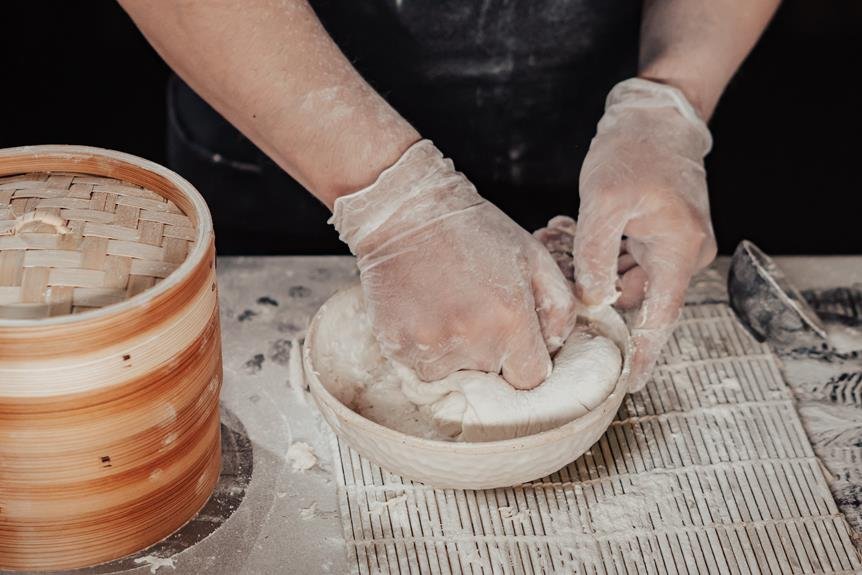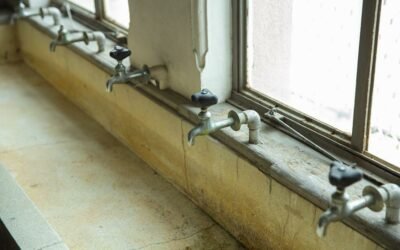Do you wonder if bamboo wood is susceptible to mold growth?
Discover the factors that influence mold development on bamboo wood, including signs to watch out for.
Learn how to prevent mold growth on bamboo wood and effectively remove any existing mold.
Follow the best practices to maintain a mold-free environment for your bamboo wood.
Stay informed and take necessary precautions to protect your bamboo wood from mold.
Key Takeaways
- High humidity levels promote mold spore germination and colonization on bamboo wood surfaces.
- Bamboo wood's resistance to mold can be compromised if the humidity level exceeds the recommended range of 40-60%.
- Regularly monitoring and adjusting humidity levels preserves the integrity and longevity of bamboo wood products.
- Controlling humidity levels through the use of dehumidifiers or air conditioners can help prevent mold growth.
Factors Affecting Bamboo Wood Mold Growth
The humidity level in your environment greatly influences the growth of mold on bamboo wood. Mold requires moisture to grow, and high humidity provides the perfect conditions for its development. When the humidity levels are above 70%, it creates a damp environment that promotes mold spore germination and colonization on bamboo wood surfaces.
Bamboo wood is naturally resistant to mold and fungi due to its high density and low moisture content. However, if the humidity level in your environment exceeds the recommended range of 40-60%, it can compromise bamboo wood's resistance, making it susceptible to mold growth.
Excessive moisture in the air increases the water content in bamboo wood, creating an ideal breeding ground for mold. As the humidity level rises, the moisture is absorbed by the bamboo wood fibers, providing a nourishing environment for mold spores to thrive. The longer the bamboo wood remains in a high humidity environment, the greater the chance of mold growth.
To prevent mold growth on bamboo wood, it's essential to control the humidity levels in your environment. Using dehumidifiers or air conditioners can help maintain optimal humidity levels, ensuring that moisture isn't retained in the air or absorbed by the bamboo wood. Regularly monitoring and adjusting the humidity levels will help preserve the integrity and longevity of bamboo wood products.
Signs of Mold on Bamboo Wood
If you suspect mold on your bamboo wood, there are several telltale signs to look out for. Mold growth on bamboo wood can be identified through visual cues and musty odors. Inspecting your bamboo wood regularly is essential to catch mold growth early and prevent further damage. Here are some signs to watch for:
| Signs of Mold on Bamboo Wood | Description |
|---|---|
| Discoloration | Look for patches or spots of discoloration on the surface of the bamboo wood. Mold can appear in different colors, including green, black, or brown. |
| Fuzzy or Powdery Texture | Mold growth often has a fuzzy or powdery appearance. Run your fingers along the surface of the bamboo wood to check for any unusual textures. |
| Musty Odor | Mold growth is often accompanied by a strong musty smell. If you notice a lingering unpleasant odor near your bamboo wood, it could indicate mold presence. |
| Warping or Buckling | Mold can cause the bamboo wood to warp or buckle. Pay attention to any changes in the shape or structure of your bamboo wood. |
| Allergic Reactions | If you or anyone in your household experiences allergy-like symptoms such as sneezing, coughing, or skin irritation when near the bamboo wood, it could be a sign of mold contamination. |
Preventing Mold on Bamboo Wood
To prevent mold on your bamboo wood, regularly inspecting and maintaining its cleanliness is crucial. Mold thrives in damp and humid environments, so it's important to keep your bamboo wood dry and well-ventilated.
Start by wiping down the surface of the bamboo wood regularly with a dry cloth to remove any dust or moisture. Avoid using excessive water or harsh chemicals, as these can damage the bamboo and create a favorable environment for mold growth.
In addition to regular cleaning, it's important to address any spills or moisture immediately. Bamboo wood is naturally resistant to water, but prolonged exposure can still lead to mold growth. Use a clean, dry cloth to blot up any spills and ensure that the surface is thoroughly dried. If necessary, use a fan or dehumidifier to help speed up the drying process.
To further prevent mold on your bamboo wood, consider applying a protective coating or sealant. This will help to create a barrier against moisture and make cleaning easier. Be sure to choose a product that's specifically designed for use on bamboo wood and follow the manufacturer's instructions for application.
Removing Mold From Bamboo Wood
Regularly inspect and clean your bamboo wood to effectively remove mold. Mold can thrive in damp and humid conditions, so it's crucial to maintain a dry and well-ventilated environment for your bamboo wood. If you notice any signs of mold, such as discoloration, musty odor, or a fuzzy texture, it's important to address the issue promptly to prevent further damage.
To remove mold from bamboo wood, start by wearing protective gloves and a mask to avoid direct contact with the mold spores. Begin by gently brushing off any loose mold using a soft-bristle brush or a cloth. Then, mix a solution of equal parts water and vinegar or hydrogen peroxide. Apply the solution to the affected area using a sponge or cloth, making sure to cover the entire mold-infested surface. Allow the solution to sit for about 15 minutes to effectively kill the mold.
Next, scrub the area using a brush or sponge to remove the mold stains. Rinse the area thoroughly with clean water and wipe it dry with a clean cloth. Ensure that the bamboo wood is completely dry to prevent the mold from returning. If the mold persists, you may need to use a commercial mold removal product specifically designed for bamboo wood.
Regularly inspecting and cleaning your bamboo wood will help prevent mold growth and maintain its beauty and durability. Remember to address any signs of mold promptly to protect your bamboo wood investment.
Best Practices for Maintaining Mold-Free Bamboo Wood
Maintaining a dry and well-ventilated environment is essential for preventing mold growth on your bamboo wood. Moisture is the primary catalyst for mold development, making it crucial to keep your bamboo wood dry at all times. Here are some best practices to ensure your bamboo wood remains mold-free:
| Best Practices | Explanation |
|---|---|
| Regular cleaning | Regularly clean your bamboo wood to remove dirt and debris. |
| Proper storage | Store bamboo wood in a dry area with good air circulation. |
| Avoid direct sunlight | Protect bamboo wood from direct sunlight to prevent drying. |
| Use a dehumidifier | Utilize a dehumidifier to maintain optimal humidity levels. |
| Apply a mold-resistant finish | Apply a mold-resistant finish to protect your bamboo wood. |
Conclusion
In conclusion, bamboo wood can be prone to mold growth if not properly taken care of. Factors such as high humidity, lack of ventilation, and moisture can contribute to mold development.
It's essential to identify signs of mold early on and take appropriate actions to prevent its growth. Regular cleaning, proper drying, and applying mold-resistant treatments can help maintain mold-free bamboo wood.
By following these best practices, you can ensure the longevity and quality of your bamboo wood products.






0 Comments